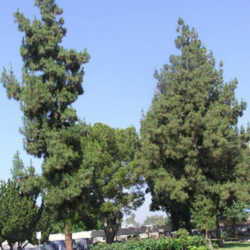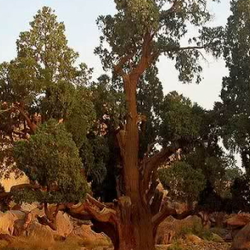 |
Two Italian cypresses add an architectural touch to the plain facade of Mission San Miguel. |
Italian cypress (Cupressus sempervirens) is native to the eastern Mediterranean region but has been planted all over the world where the winters allow. The Missouri Botanical Garden reports it to be hardy in zone 7 and warmer and the PlantFiles reports it to be hardy in zone 8 and warmer. The recommended Sunset zones are 4-24, 29-32, H1, and H2, which (aside from the Hawaiian zones) forms an arc from western Washington, to southern California, to Texas, to Georgia, and north to Delaware and New Jersey. Though it can and has been grown across this region, it is reported to do best and look at its best in drier regions with hot summers, like inland California and the Southwest. The plant is as ubiquitous as palm trees in some southern California neighborhoods. I had to walk only about 150 yards from my house to see at least ten separate plantings of this tree. Where it is too cold for the tree to grow, Lombardy poplars have been used for the same visual effect.
In the United States, the tree is usually called Italian cypress, though it is debatable if it is even native to Italy. Mediterranean cypress, Tuscan cypress, Spanish cypress, and funeral cypress are other common names. Another common name is pencil pine and though it is a conifer, it is not a pine, that is, of the genus Pinus.
The trees can get up to 60 feet tall and five to ten feet wide. Smaller cultivars of half that size are available. The trees are long-lived and some trees are reported to be 1800 years old. The wood is aromatic and was used to construct coffins in ancient Egypt and to make the entrance doors of St. Peter's Basilica.
 |
Like a subject from Ovid's Metamorphoses, a row of cypresses turns into a row of columns |
Wild Italian cypress trees in their normal form have horizontal branches like most of the rest of the genus Cupressus. The rigidly vertical trees seen in landscaping are mutations that have been saved and propagated for centuries. These are sometimes referred to as variety 'Stricta' or 'Fastigiata'. Some of the many cultivars and varieties include the following:
- 'Contorta' - twisted branchlets;
- 'Glauca' - blue-green foliage;
- 'Gold Rocket' - more intense pale gold than 'Swane's Golden';
- 'Gracilis' - a variety suited to the climate of New Zealand;
- 'Green Pencil' (AKA 'Green Spire') - narrower form;
- 'Laredo Candelabra' - outward arching branches like a candelabrum;
- 'Monshel' (AKA Tiny Tower™) - smaller variety;
- 'Monstrosa' - dwarf, with short, thick branches, often monstrose;
- 'Nitschke's Needle' (AKA 'Karoonda') - faster growing, very narrow;
- SANCOREY® 'Jr 2000' - canker resistant;
- 'Swane's Golden' - golden new growth;
- 'Swane's Variegated' - variegated yellow;
- 'Variegata' - variegated pale yellow and white; and
- 'Totem' - wind-resistant.
 |
Shaded yard with a shady past - trees were planted to block curious eyes back when pornographic movies where filmed at this house. |
Italian cypresses are recommended for narrow spaces. Reportedly, the roots are deep enough to not be shallow obstacles to mowing and gardening or damaging to buildings and sidewalks. The trees require virtually no trimming, though some of the more generic 'Stricta' plants may occasionally produce a horizontal branch that should be removed for aesthetic reasons. Young plants or small cultivars are sometimes trimmed as topiaries.
Some people find the cones unattractive, but it is reported that seed cones only form in regions with cold winters. Unfortunately, Italian cypress pollen is a major allergen in areas where the tree is common. As many as 24 to 30 percent of the people with hay fever in Italian cypress regions may be allergic to it.[1]
The trees are often planted in rows as windbreaks or privacy screens. Be aware that a single row of trees will do little to dampen the noise of traffic or neighbors. Planted on the sunny side of a wall, they can be used to mask a plain concrete block wall. Where the sun is sufficient, the trees will keep their foliage nearly to ground level, though extremely old trees can have a bit of bare trunk.
Italian cypress is a darker green than many plants and this color, along with its serious-looking form, makes me think it is a rather funereal looking tree. I must not be the only one to think that way, for in some countries, Italian cypress are planted in graveyards, much like arborvitae has been used in the United States. Although rows of the trees can look very formal, random plantings also work in more naturalistic settings. The look of the tree has been admired for millennia by people as diverse as Roman emperors, Impressionist painters, Tuscan farmers, and Californian suburbanites.
[1] AllergyNet, Italian Funeral Cypress tree
















